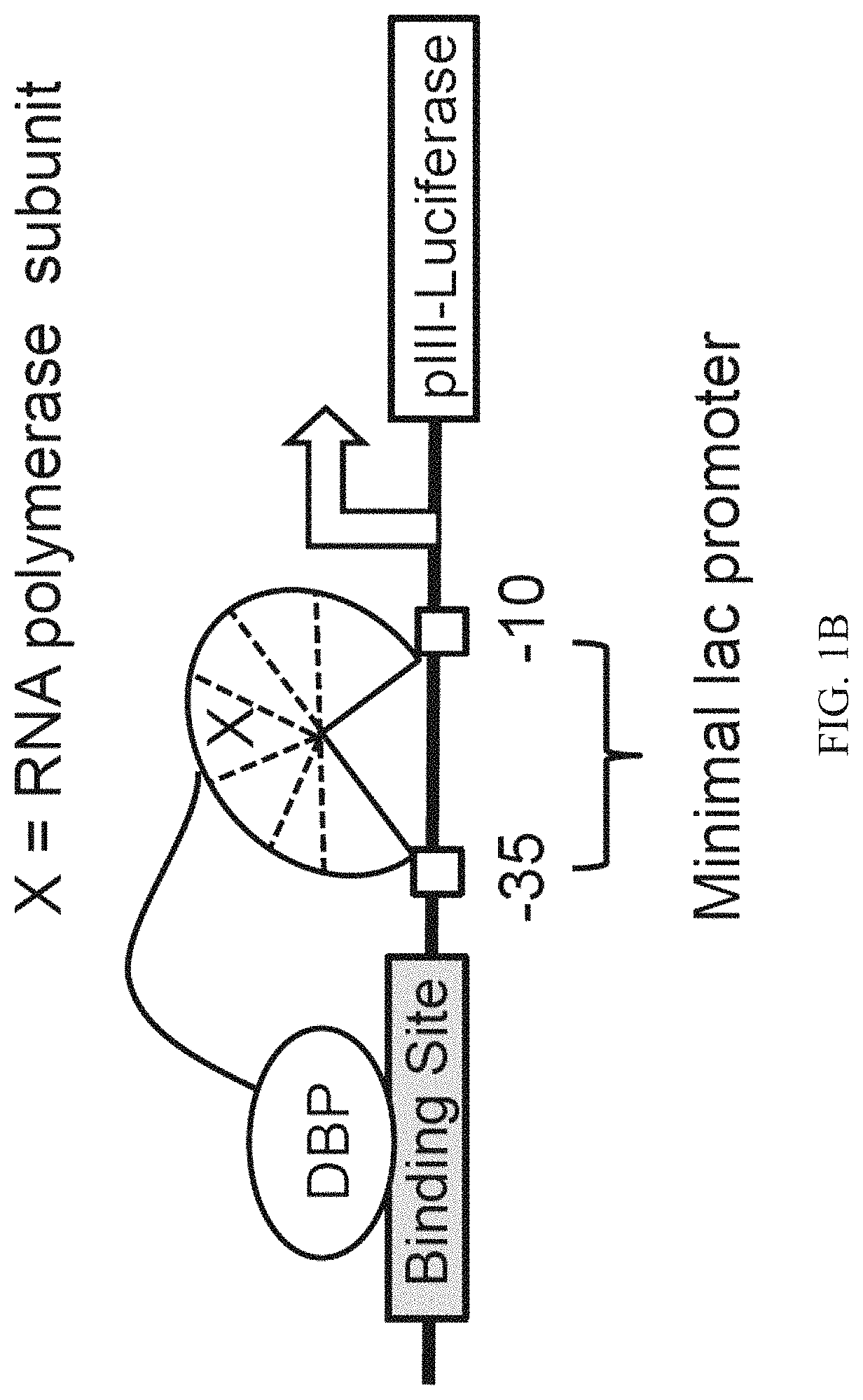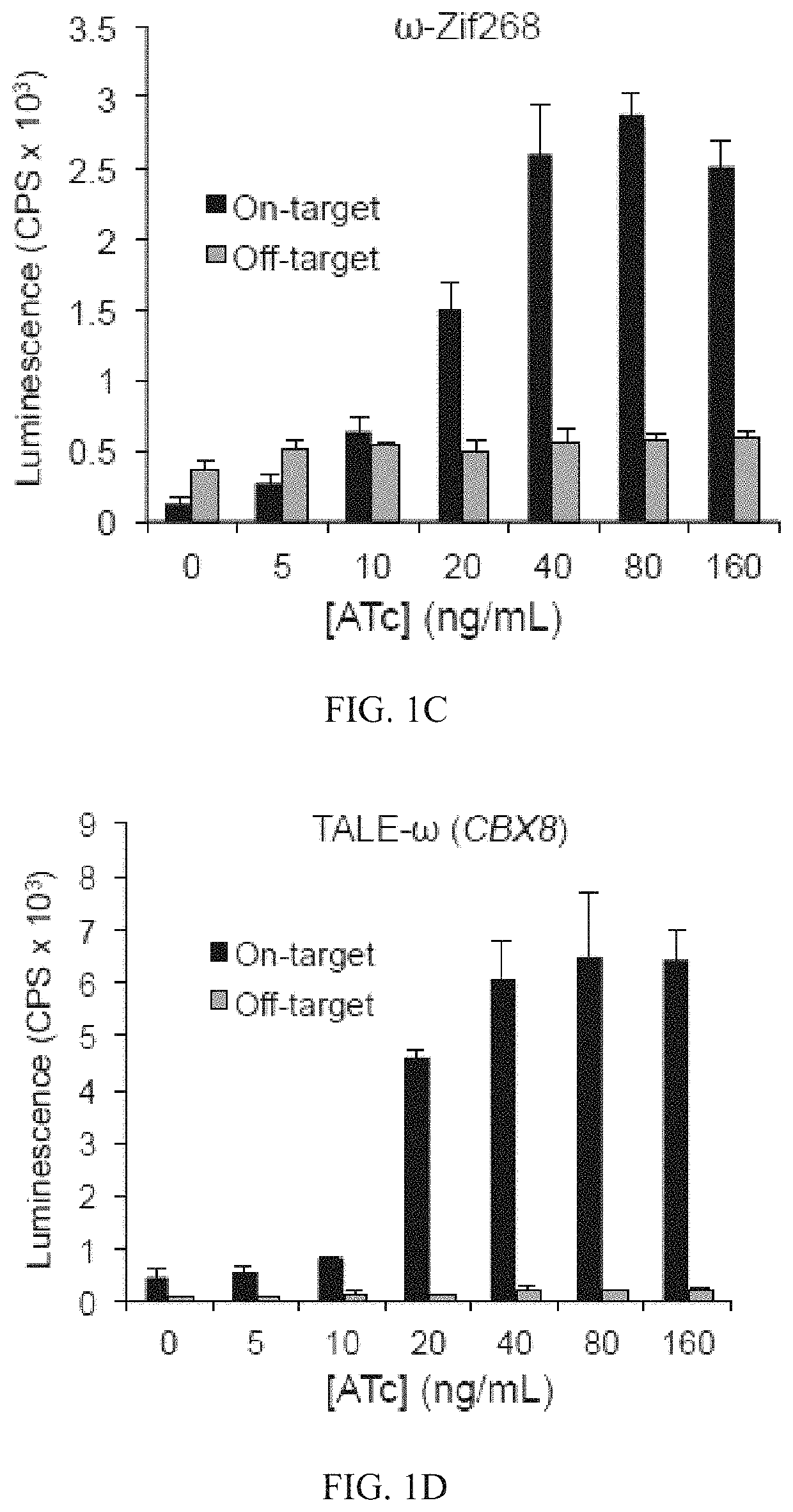Evolution of TALENs
a technology of talens and dna sequences, applied in the field of evolution of talens, can solve the problems of not being able to enhance the specificity of a particular tale array in a targeted manner by reducing the ability of the tale array to bind to specific off-target dna sequences found in the genome, and achieve the effect of improving the specificity of a dna-binding domain
- Summary
- Abstract
- Description
- Claims
- Application Information
AI Technical Summary
Benefits of technology
Problems solved by technology
Method used
Image
Examples
example 1
Development of a PACE System for DNA-Binding Activity
[0157]To develop a PACE-compatible DNA-binding selection, a DNA-binding domain of interest was linked to a subunit of bacterial RNA polymerase III (RNAP). It was intended that binding of this fusion protein to operator sequences upstream of a minimal lac promoter would induce transcription of a downstream gene III-luciferase reporter through recruitment or stabilization of the RNAP holoenzyme (FIG. 1B). To validate this strategy, an assay was developed that transduces cognate DNA-binding of the DBD from Zif268 (residues 333-420)37, expressed from a tetracycline-inducible promoter, into activation of pIII-luciferase expression. This assay was used to evaluate a variety of DNA operator locations (at −55 and −62 bp with respect to the transcription initiation site)36,38 and RNA polymerase fusion architectures. Fusing the RNAP ω subunit to the N-terminus of Zif268 with an 11-residue linker resulted in ≥10-fold increase in pIII-lucifer...
example 2
s Evolution of TALE 5′ Specificity
[0160]This system was used to continuously evolve TALE proteins with novel properties. A series of C-terminal fusions between a previously reported TALE array targeting CBX8 (right half-site TALE)18, and the RNAP ω subunit were tested. Fusions using a linker of 18 or 28 amino acids of the natural TALE C-terminus followed by a GGGGS sequence resulted in >10-fold gene activation in a luciferase assay (FIG. 10A). The sequence specificity of the system was verified using an off-target sequence in the luciferase assay, and performed on- and off-target colorimetric plaque assays using TALE-ω SP and host cells harboring the AP containing the target CBX8 sequence. Similar to the findings with zinc fingers, both luciferase expression and phage propagation were dependent on the presence of the cognate TALE binding site (FIG. 10B). Finally, PACE was performed for 24 h on the cognate AP to optimize the SP backbone. This experiment resulted in several mutations ...
example 3
s Evolution of Improved TALEN Specificity
[0169]TALE arrays are frequently used in the context of TALENs to initiate genome editing7. The DNA cleavage specificity of TALENs is imperfect, and off-target DNA sites can undergo TALEN-mediated modification at appreciable levels both in vitro and in human cells30,42,43 that compromise their usefulness as research tools and potential human therapeutics. It was determined whether DB-PACE could be used to evolve TALEs with improved specificity for a given target sequence by decreasing recognition of specific off-target genomic sequences while maintaining recognition of the on-target sequence. Off-target genomic sequences can be identified using in vitro high-throughput specificity profiling30,44,45 or other approaches20,42,46,47.
[0170]To validate the ability of DB-PACE to improve TALEN specificity, a TALEN pair that targets a 36-bp sequence within the human ATM locus was used (see Table 2 for target sequences) for which off-target cleavage si...
PUM
| Property | Measurement | Unit |
|---|---|---|
| volume | aaaaa | aaaaa |
| volume | aaaaa | aaaaa |
| volume | aaaaa | aaaaa |
Abstract
Description
Claims
Application Information
 Login to View More
Login to View More - R&D
- Intellectual Property
- Life Sciences
- Materials
- Tech Scout
- Unparalleled Data Quality
- Higher Quality Content
- 60% Fewer Hallucinations
Browse by: Latest US Patents, China's latest patents, Technical Efficacy Thesaurus, Application Domain, Technology Topic, Popular Technical Reports.
© 2025 PatSnap. All rights reserved.Legal|Privacy policy|Modern Slavery Act Transparency Statement|Sitemap|About US| Contact US: help@patsnap.com



